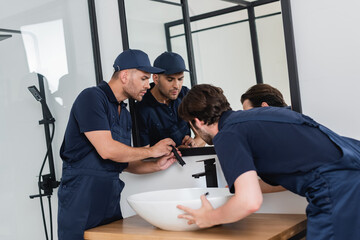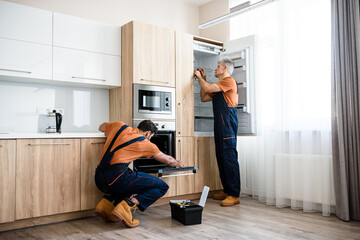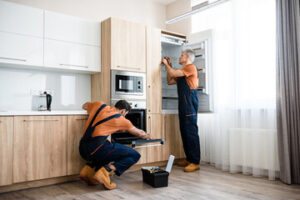Commercial plumbers install, repair, and maintain plumbing systems in large buildings such as office spaces, restaurants, hotels, and hospitals. They are responsible for ensuring these plumbing systems comply with health and safety regulations.
A problem like a sewer leak or clogged drain can disrupt business operations and cause costly damage. This is why regular maintenance and emergency services are so essential. Contact Plumbers Bradenton for professional help.
If you are looking to install a new plumbing system in your commercial space, a commercial plumber is the person to call. They can help you set up a water supply for an entire building, or you might need a simple fixture installed such as a sink faucet. A commercial plumber can handle any type of installation job that comes their way, even ones that involve a lot of pipes and multiple stories.
In addition to installing systems in commercial spaces, they also repair them. When something goes wrong with a plumbing fixture at a business, such as a clogged drain or a broken water heater, you will need to hire a commercial plumber to come in and take care of it immediately. This is because businesses often see more traffic than a residential home, so the fixtures are used more frequently. This can lead to wear and tear much quicker than it would in a home.
Another service that commercial plumbers provide is backflow testing and certification. This is a necessary service to ensure that the water coming into a business from the public water supply is clean and safe for everyone in the building. This includes customers, employees and anyone else who might visit the space. If there are issues with backflow, a commercial plumber can test the water for contaminants and make sure that it is safe to use before it is sent out into the public space.
When a problem arises with a plumbing fixture, it is often easier for residential plumbers to identify and fix the issue. After all, they have seen it all before. But when a commercial plumber is called to a property, it can be much more difficult to find the source of the problem. This is because many businesses, such as hospitals and office buildings, have extensive piping in their space. Commercial plumbers must be able to work with these types of complex systems in order to fix the problem quickly.
Another reason why a commercial plumber is needed is because they must deal with more regulations than residential plumbers do. This may include having higher insurance coverage or working on certain days of the week (like weekends) at a business location.
Plumbing Repair
Commercial plumbing repair services are available for businesses and organizations that experience issues with their water fixtures, toilets, or drainage systems. These services include fixing leaks, clogged drains, and water heater repairs. Commercial plumbers also offer maintenance and inspection services to keep the plumbing system running smoothly.
Because commercial plumbing systems are larger than residential ones, it can take a while to diagnose and repair problems. This is especially true if the issue involves multiple pipes or fixtures. In addition, a commercial plumber may have to work with building owners to find the source of the problem and agree on a solution. Service and repair plumbers have strong problem-solving skills and the know-how to fix a wide range of plumbing issues.
In addition to repairing and maintaining commercial plumbing systems, commercial plumbers can help their clients with new construction projects by installing plumbing fixtures and pipes. They can also work with engineers and architects to design plumbing systems for new buildings or renovations of existing structures.
Another important service that commercial plumbers provide is backflow prevention. This service helps prevent contaminated water from entering the potable water supply. It involves installing devices that prevent reverse flow of sewage or dirty water into the clean water supply. Commercial plumbers can install and maintain these backflow preventer devices in commercial and industrial buildings.
When an issue occurs with a plumbing fixture or pipe, it’s essential to turn off the water supply immediately. This can prevent further damage and minimize the impact of the issue on business operations. Commercial plumbers can help clients locate the main water shut-off valve and show them how to turn it off if necessary.
While shopping for a reliable commercial plumber, look for one with a good reputation and track record. Ask for detailed quotes or estimates and make sure to clarify any questions you have about the plumbing job. You should also inquire about warranties and guarantees. Finally, consider whether the plumber offers long-term maintenance and service options. Doing so can help you save money in the long run by preventing costly repairs and downtime.
Plumbing Maintenance
Plumbing maintenance services keep your business’s water flow running smoothly and reduce the risk of costly repairs. These services include detecting and fixing leaks, cleaning pipes to ensure proper water flow, removing debris from the pipes, and more. Commercial plumbers are familiar with the unique needs of commercial properties and can help you choose the best maintenance plan for your business.
In addition to reducing the frequency of plumbing emergencies, regular maintenance can extend the lifespan of your pipes and fixtures. It also helps identify opportunities for upgrades to more efficient and sustainable plumbing technologies.
Since the plumbing systems found in commercial buildings are more complex than those in residential properties, they often require specialized equipment to maintain. Commercial plumbers have the tools and knowledge to use this specialized equipment to perform a wide range of maintenance services.
A routine inspection of your plumbing system by a professional can detect any issues before they become major problems. For example, if your pipes are leaking or have minor corrosion, a professional plumber can detect these issues before they worsen and cause extensive damage. This prevents downtime and loss of revenue for your business, and it can save you money in the long run.
In addition, a regular plumbing maintenance service can detect other potential issues, such as clogged drains and faucets, or backflow prevention devices that aren’t working properly. Commercial plumbers are also knowledgeable about local plumbing codes and regulations and can ensure your plumbing system complies with all applicable rules. This can protect your business from expensive fines and penalties.
When choosing a plumbing company to perform regular maintenance on your commercial property, look for one with a solid reputation and experience working on similar projects. They should also be available for emergency services and have the ability to accommodate your business’s schedule. It’s important to find a company that offers 24/7 support so you can contact them anytime there is an issue with your plumbing. A quality plumber will always be honest and upfront with you about their rates and fees and will never try to upsell you on additional services.
Plumbing Inspection
Commercial plumbing inspection services are a vital part of maintaining a commercial plumbing system. A plumbing inspector will look at all visible pipes and fixtures to ensure they are in good condition. They will check for leaks, corrosion, kinks and loose connections. In addition, they will test water pressure and check for any unusual noises that could indicate an issue. If there are any fixtures that are nearing the end of their lifespan, the plumber will make recommendations for replacements.
Larger fixtures like water heaters are also inspected for signs of damage or wear and tear. These fixtures can cause major problems if they are not properly maintained. For example, if a water heater develops a leak, it can create significant rust and structural damage to the building. It can also lead to expensive repairs for things like sheet rock and hardwood floors. In addition, a leaking water heater can waste money on energy costs.
In commercial buildings, the plumbing systems are typically more complex than in residential homes. This is due to the size and multiple stories of commercial structures like office buildings and malls. Because of this, it is important for commercial plumbing contractors to have a wide range of inspection tools and techniques. This allows them to identify issues and make the appropriate repairs to prevent costly emergencies down the line.
Leaks and other issues can impact the productivity of a business. For example, a customer may not return if they experience poor water flow or see puddles on the floor. In addition, a poorly maintained plumbing system can lead to water damage, which can cost the business money in repair and lost revenue.
A commercial plumber will be able to perform many of the same inspection services as a residential plumber, but they should have additional tools and training to deal with unique issues associated with larger buildings. For example, a commercial plumber will be able to test for backflow and inspect sewer lines using a video camera. They will also be able to use trenchless technologies to repair or replace underground sewer and water lines without digging up a parking lot or other costly surfaces.



 Layout
Layout
